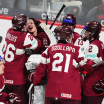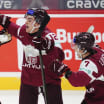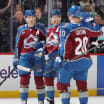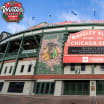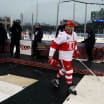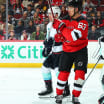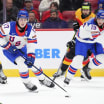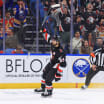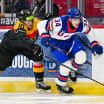Legendary hockey reporter Stan Fischler writes a weekly scrapbook for NHL.com. Fischler, known as "The Hockey Maven," shares his humor and insight with readers every Wednesday.
This week, Stan looks at one of the first families of hockey, the Conachers.
Conachers rank among first families of hockey
Brothers Lionel, Charlie, Roy inducted into Hall of Fame, two sons also played in NHL
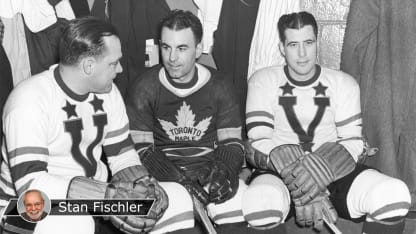
By
Stan Fischler
Special to NHL.com
Hockey always has been a family sport, whether the subject is the Sutter brothers from Viking, Alberta, the Staals from Thunder Bay, Ontario, the Brotens of Roseau, Minnesota, or the Sedin twins from Ornskoldsvik, Sweden. The lengthy list of NHL brother acts is sprinkled with everything from Hockey Hall of Famers to fourth-liners.
One of the most compelling families in NHL history is the Conacher clan of Toronto. There are no less than three Hall of Famers among that father-son quintet, each of whom played in the NHL.
Oldest brother Lionel is considered by many to be the most famous; he was voted Canada's "Athlete of the Half Century" in 1950. He was an all-sports star who was as proficient at football, lacrosse and baseball as he was hockey.
Younger brother Charlie helped the Toronto Maple Leafs win the Stanley Cup in 1932. Then there was Roy. Though he was overshadowed by his big brothers, the kid of the hockey-playing family was no slouch himself and joined Lionel and Charlie as Hall of Famers -- they are the only trio of brothers to be enshrined.
Among the next generation of Conachers, Lionel's son, Brian, and Charlie's son, Pete, also played in the NHL, though not to the level of their fathers.
Here's a look at all five Conachers, in order of their entry into the NHL:
Nicknamed "The Big Train," the eldest of the hockey-playing Conacher brothers was a defenseman who didn't start skating until he was 16 and, at first, considered a boxing career ahead of hockey; not to mention baseball (he was part of Toronto's International League championship team in 1926), football (he played on a Grey Cup-winning team in 1921) and lacrosse. But the more hockey he played, the more he impressed scouts. He signed with the Pittsburgh Pirates before the 1925-26 season and was traded to the New York Americans early in 1926-27. The Americans traded him to the Montreal Maroons in November 1930.
But It wasn't until he was traded to the Chicago Blackhawks on Oct. 1, 1933, that he found himself on a title-winning team. Lionel was an NHL First-Team All-Star and helped the Blackhawks win their first Stanley Cup championship in 1934. Chicago traded him back to the Maroons six months later, and he helped his new team win the Cup in 1935.
A natural athlete, Lionel created new defensive techniques in the NHL. One of the most successful involved sliding across the ice on one knee to deflect a puck out of danger. That earned him a nickname -- "The Traveling Netminder."
Lionel's second stint with the Maroons lasted three seasons, and although he was an NHL Second-Team All-Star and runner-up in voting for the Hart Trophy as League MVP in 1936-37, he opted to retire in after a dozen seasons in the NHL -- in an article in Maclean's magazine, he recounted the physical toll his years as an athlete had taken on him. The elder Conacher was elected to the Hall of Fame in 1994, and the trophy honoring Canada's Outstanding Male Athlete of the year bears his name.
The middle brother among the three NHL Conachers earned the nickname "The Big Bomber" because of his dynamic shot, which made life miserable for goalies in the pre-mask age. Charlie was the second captain of the Maple Leafs and one of their first genuine stars. He scored the first Toronto goal at Maple Leaf Gardens on
Nov. 12, 1931
, and on
Jan. 19, 1932
, he became the first Maple Leafs player to score five goals in a game.
Conacher played right wing with
Joe Primeau
at center and
Busher Jackson
on left wing on "The Kid Line," one of the best in the NHL during the 1930s -- during a seven-season span from 1929-36, they piled up nearly 800 points. The threesome helped power the Maple Leafs to the Stanley Cup in 1932.
A three-time First-Team NHL All-Star, Conacher led the NHL in scoring in 1934 and 1935. He led or tied for the NHL lead in goals five times from 1930-31 through 1935-36.
Charlie was regarded by many analysts of the era as the best all-around player among the three brothers, and he was the only one
named to the 100 Greatest NHL Players
during the League's Centennial in 2017. Conacher remained with the Maple Leafs for nine seasons, then was traded to the Detroit Red Wings and later to the Americans. He helped them to their last winning season in 1937-38 and a playoff series victory over the archrival New York Rangers.
Conacher retired in 1941 and was inducted into the Hall of Fame in 1961.
Roy Conacher
Following a brother act like Lionel and Charlie was no walk in the park for their kid brother -- Roy was 15 years younger than Lionel and seven years younger than Charlie. But "The Forgotten Conacher" made his own impact because of his scoring touch.
"Roy skated in the shadows of Lionel and Roy, but he was every inch the Hall of Famer his two brothers were," historian Andrew Podnieks wrote in his 2003 book, "Players: The Ultimate A-Z Guide of Everyone Who Has Ever Played in the NHL."
Like Lionel and Charlie, Roy learned to play in Toronto's amateur leagues. He joined Boston Bruins in 1938-39 and showed right off the bat that he could shoot as hard as Charlie by leading the NHL with 26 goals in a 48-game season.
Though Conacher was overshadowed by the "Kraut Line" of
Milt Schmidt
,
Bobby Bauer
and
Woody Dumart
, he played a key role in Boston's Stanley Cup championships in 1939 and 1941. However, at what would have been the peak of his NHL career, Roy spent four years in the Royal Canadian Air Force during World War II. He returned to the Bruins at the end of the 1945-46 season, but general manager Art Ross mistakenly thought his legs were gone and traded him to the Detroit Red Wings in August 1946.
Roy wasted no time showing he was far from washed up, scoring an NHL career-high 30 goals in 1946-47. However, the Red Wings sold Conacher to the Blackhawks before the 1947-48 season (freeing up No. 9 for Gordie Howe to wear). Roy scored at least 24 goals in each of the next four seasons and led the NHL in scoring in 1948-49 with 68 points (26 goals, 42 assists) in 60 games, playing mostly on a line with fellow future Hall of Famers
Bill Mosienko
and
Doug Bentley
.
Conacher retired after playing 12 games in the 1951-52 season and was inducted into the Hall of Fame in 1998.
His given name was Charles Jr., but everyone referred to the son of "The Big Bomber" as Pete.
When the Blackhawks were foundering in the early 1950s, GM Bill Tobin figured he'd have a drawing card with another Conacher. Pete made his NHL debut, a two-game cameo, as a 19-year-old in 1951-52 and became an NHL regular the following season.
But It didn't work out the way Tobin had envisioned. Unlike his husky dad and uncles Lionel and Roy, Pete was relatively thin and didn't have the hockey skills that they had.
After 2 1/2 seasons with Chicago, Tobin stopped waiting for Pete to be like his father and traded him to the Rangers along with defenseman
Bill Gadsby
for defenseman
Allan Stanley
and forward
Nick Mickoski
on Nov. 23, 1954.
However, the Rangers were rebuilding with talented young forwards such as
Andy Bathgate
,
Dean Prentice
and
Aldo Guidolin
. Pete wound up on the third line for 1 1/2 seasons, was sold to the Maple Leafs and was out of the NHL after the 1957-58 season.
But like all the Conachers, Pete managed to skate for a championship team. After retiring from the NHL, he was reinstated as an amateur so he could join the Belleville McFarlands, a senior team that represented Canada at the 1959 World Ice Hockey Championship and finished first. He then went to the American Hockey League and played seven seasons, the final six with Hershey, where he showed the Conacher scoring touch by averaging 30 goals during a four-season span in his early 30s.
Lionel's son carried the family name into the NHL during the 1960s, though with different results.
The Maple Leafs gave him a one-game tryout in 1961-62 season, but Brian then opted to join Canada's National Team. He played at the 1964 Innsbruck Olympics, scoring seven goals in seven games. He returned to the pros after playing for Canada at the 1965 World Ice Hockey Championship and spent most of the 1965-66 season with Rochester of the American Hockey League. Brian made the Maple Leafs in 1966-67, finishing third in voting for the
Calder Trophy
as the NHL's top rookie with 27 points (14 goals, 13 assists) in 66 games.
The Maple Leafs, one of the oldest teams in NHL history, were underdogs to the first-place Blackhawks in the Stanley Cup Semifinals. But after Toronto won Game 5 at Chicago Stadium to take a 3-2 lead in the best-of-7 series, Brian stepped up with two goals, including the game-winner, in a
3-1 victory in Game 6
that put Toronto into the Stanley Cup Final against the Montreal Canadiens.
Conacher had a goal and an assist to help the Maple Leafs defeat the Canadiens in six games. "This has to be the greatest thing to happen to any hockey player, especially a rookie like me," Brian said with his arms wrapped around the Cup.
That turned out to be the highlight of his playing career. He had 25 points (11 goals, 14 assists) in 64 games with Toronto in 1967-68, then was sent back to the minors. He returned to the NHL with the Detroit Red Wings in 1971-72, then played for Ottawa of the World Hockey Association in 1972-73 before retiring as a player.
But Brian's hockey career didn't end there. He went on to coach in college and the minor leagues, served as general manager of the WHA's Indianapolis Racers and Edmonton Oilers, was a TV analyst for coverage of the 1972 Summit Series and the 1976 Innsbruck Olympics, and managed Maple Leaf Gardens for many years.



